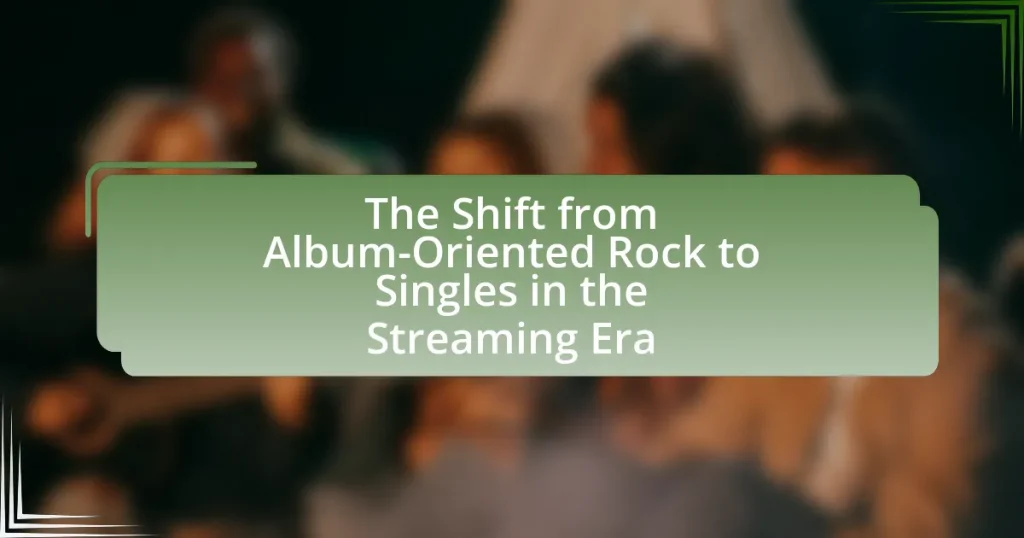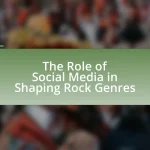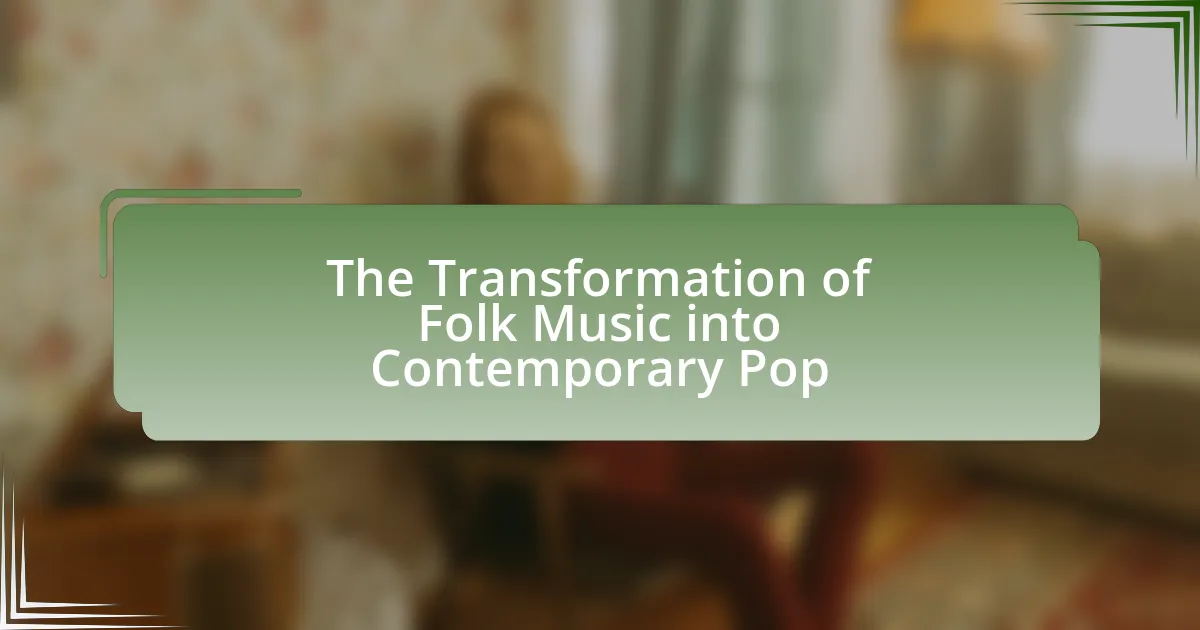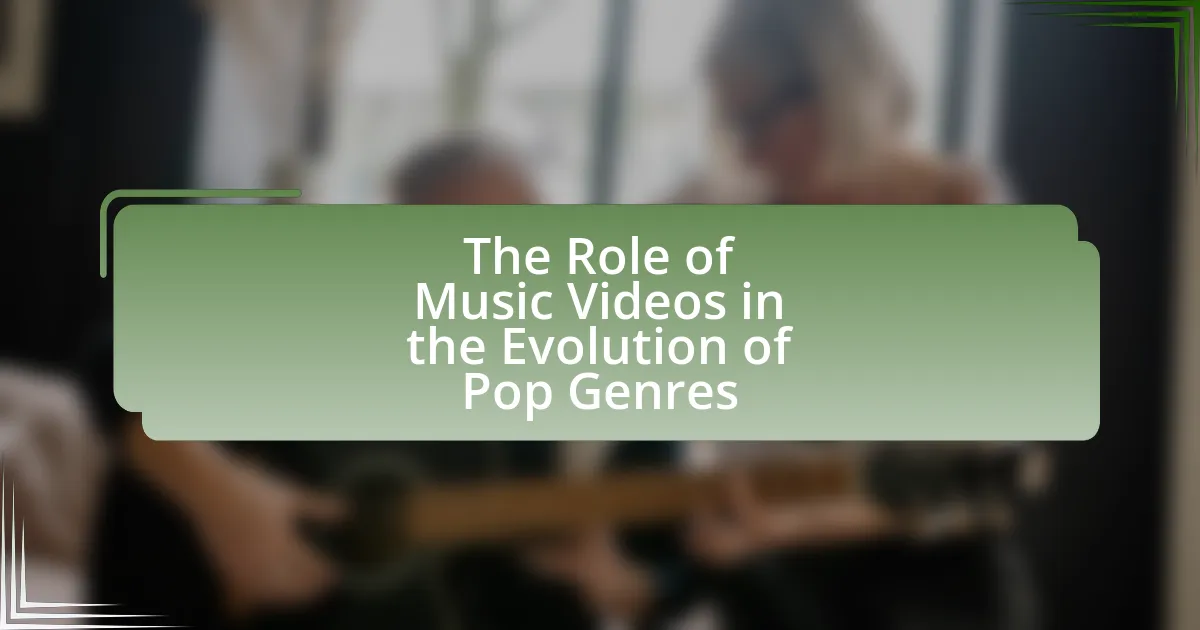The article examines the transition from album-oriented rock to singles in the streaming era, highlighting significant changes in music consumption patterns. It discusses how streaming platforms like Spotify and Apple Music have shifted listener preferences towards individual tracks, with single track downloads accounting for 80% of music purchases in 2020. The piece also explores the impact of technological advancements, cultural shifts, and the evolving role of artists in adapting to this new landscape, emphasizing the implications for music production, marketing strategies, and artist-fan relationships in a digital age.
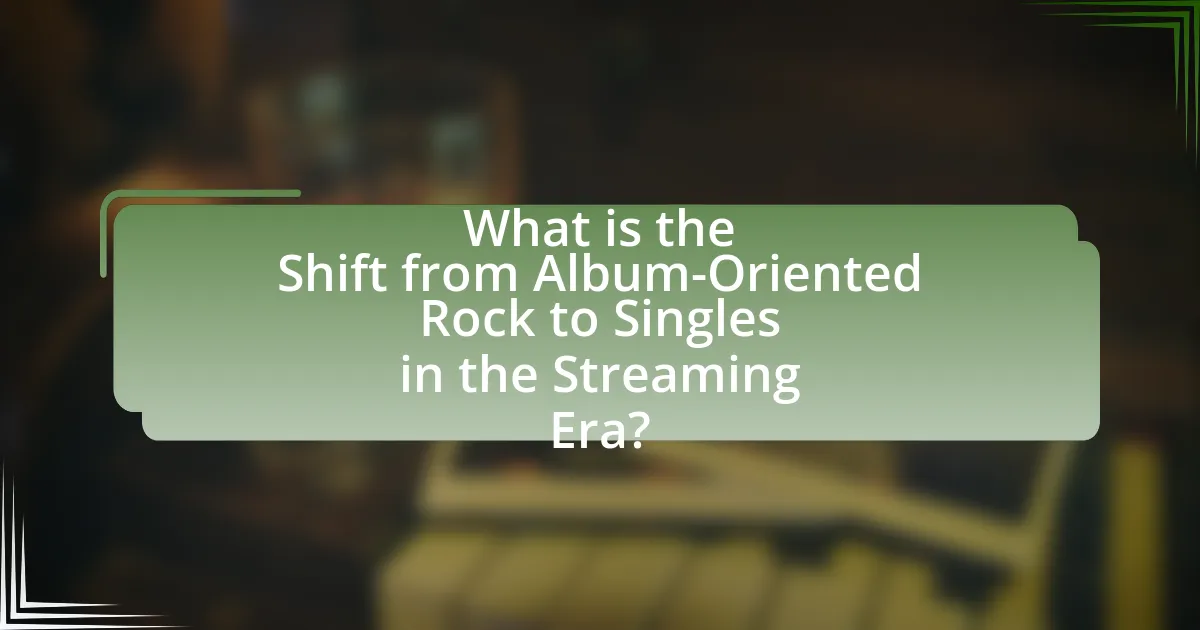
What is the Shift from Album-Oriented Rock to Singles in the Streaming Era?
The shift from album-oriented rock to singles in the streaming era signifies a fundamental change in music consumption patterns, where listeners increasingly favor individual tracks over full albums. This transition is driven by the accessibility and convenience of streaming platforms, which allow users to easily discover and play specific songs without the commitment of listening to an entire album. According to a report by Nielsen Music, in 2020, single track downloads accounted for 80% of all music purchases, highlighting the preference for singles in the current market. Additionally, streaming services like Spotify and Apple Music prioritize playlists and curated content, further promoting the consumption of singles over albums.
How has the music consumption landscape changed with streaming?
The music consumption landscape has shifted significantly with the rise of streaming, leading to a preference for singles over full albums. Streaming platforms like Spotify and Apple Music have made it easier for listeners to access individual tracks, resulting in a decline in album sales; for instance, in 2020, single track downloads accounted for 80% of digital music sales, while album sales dropped by 23% compared to the previous year. This change reflects a broader trend where consumers favor curated playlists and instant access to popular songs, reshaping how artists release music and how listeners engage with it.
What role do streaming platforms play in music accessibility?
Streaming platforms significantly enhance music accessibility by providing users with instant access to vast libraries of songs and albums from various genres and artists. These platforms, such as Spotify and Apple Music, allow users to listen to music on-demand, breaking geographical and financial barriers that previously limited access to music. According to a report by the International Federation of the Phonographic Industry (IFPI), streaming services accounted for 62% of global recorded music revenues in 2020, illustrating their pivotal role in making music widely available to audiences worldwide.
How has listener behavior evolved in the streaming era?
Listener behavior has evolved significantly in the streaming era, shifting from a focus on full albums to an emphasis on individual singles. This change is driven by the accessibility and convenience of streaming platforms, which allow users to easily discover and listen to specific tracks without committing to an entire album. According to a report by Nielsen Music, in 2020, single-track consumption accounted for 80% of all music streams, highlighting the preference for singles over albums. Additionally, the rise of curated playlists and algorithm-driven recommendations has further influenced listeners to engage with more diverse and shorter content, reinforcing the trend away from traditional album-oriented listening.
Why did Album-Oriented Rock dominate the music scene?
Album-Oriented Rock (AOR) dominated the music scene primarily due to its emphasis on cohesive albums that showcased artistic expression and storytelling. This genre emerged in the late 1960s and 1970s, with bands like Pink Floyd and The Eagles creating albums that were designed to be experienced as a whole rather than through individual hit singles. The rise of FM radio, which favored longer tracks and album cuts over short singles, further propelled AOR’s popularity, allowing listeners to engage deeply with the music. Additionally, the cultural context of the time, including the counterculture movement, encouraged a focus on artistic integrity and album craftsmanship, solidifying AOR’s dominance in the music landscape.
What characteristics define Album-Oriented Rock?
Album-Oriented Rock (AOR) is characterized by its focus on the album as a cohesive artistic statement rather than just a collection of singles. AOR typically features longer songs, complex arrangements, and thematic continuity throughout the album, which encourages listeners to experience the work in its entirety. This genre emerged in the 1970s, with bands like Pink Floyd and Fleetwood Mac exemplifying these traits through concept albums that tell a story or explore a specific theme. The emphasis on album artistry over individual tracks was a significant shift in the music industry, influencing how music was produced and consumed during that era.
How did Album-Oriented Rock influence artist creativity and album production?
Album-Oriented Rock (AOR) significantly influenced artist creativity and album production by encouraging musicians to focus on cohesive thematic and sonic experiences rather than just individual hit singles. This genre, which emerged in the late 1960s and 1970s, emphasized the album as an artistic statement, leading artists to experiment with longer compositions, concept albums, and intricate production techniques. For instance, bands like Pink Floyd and The Beatles utilized studio technology to create immersive soundscapes, which not only showcased their creativity but also set new standards for album production quality. The success of AOR albums, such as Fleetwood Mac’s “Rumours,” which sold over 40 million copies, demonstrated the commercial viability of this approach, further motivating artists to invest time and resources into crafting albums that resonated with listeners on multiple levels.
What factors contributed to the decline of Album-Oriented Rock?
The decline of Album-Oriented Rock (AOR) was primarily driven by the rise of digital music consumption and the streaming model, which favored singles over full albums. As platforms like Spotify and Apple Music gained popularity, listeners increasingly gravitated towards curated playlists and individual tracks, diminishing the traditional album format’s significance. Additionally, the shift in consumer behavior towards instant gratification and accessibility led to a decreased investment in the cohesive storytelling and artistic expression that characterized AOR. This transition was further exacerbated by changes in radio programming, which began to prioritize hit singles over album tracks, reflecting the evolving music industry landscape.
How did technological advancements impact music production and distribution?
Technological advancements significantly transformed music production and distribution by enabling digital recording, editing, and streaming. Digital audio workstations (DAWs) like Pro Tools and Logic Pro allowed artists to produce high-quality music from home studios, reducing the need for expensive studio time. Additionally, the rise of the internet and platforms like Spotify and Apple Music revolutionized distribution, allowing artists to reach global audiences instantly without traditional record labels. According to a report by the International Federation of the Phonographic Industry (IFPI), streaming accounted for 62.1% of global recorded music revenue in 2020, illustrating the shift from physical album sales to digital access. This transition has led to a focus on singles rather than albums, as artists adapt to consumer preferences for on-demand listening.
What cultural shifts led to a preference for singles over albums?
The cultural shifts that led to a preference for singles over albums include the rise of digital streaming platforms and changes in consumer behavior. Streaming services like Spotify and Apple Music prioritize individual tracks, allowing listeners to easily access and share specific songs rather than entire albums. This shift is supported by data showing that in 2020, singles accounted for 80% of all music consumption in the U.S., reflecting a significant change in how audiences engage with music. Additionally, the fast-paced nature of social media and the desire for instant gratification have further encouraged listeners to favor singles, as they can quickly discover and enjoy new music without committing to a full album.
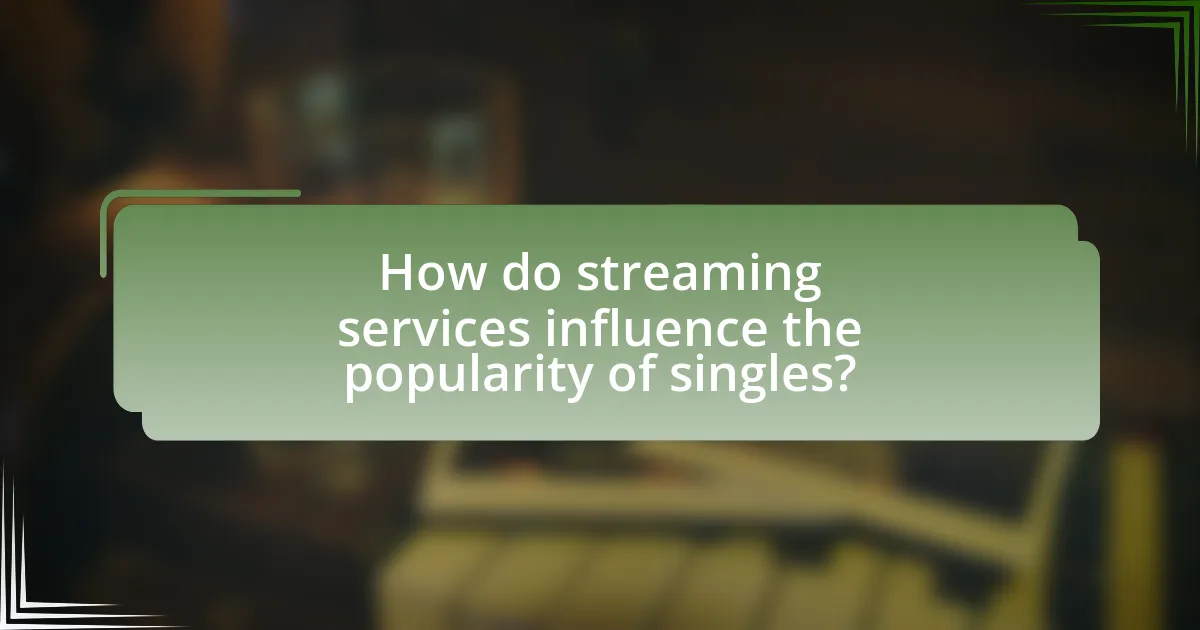
How do streaming services influence the popularity of singles?
Streaming services significantly influence the popularity of singles by providing immediate access to a vast library of music, which encourages listeners to discover and share individual tracks rather than entire albums. This shift is evidenced by the rise of playlists, such as Spotify’s “Today’s Top Hits,” which can propel a single to viral status, as seen with tracks like “Old Town Road” by Lil Nas X, which gained immense popularity through streaming playlists. Additionally, data from the Recording Industry Association of America (RIAA) indicates that streaming now accounts for over 80% of music industry revenue, highlighting the central role of streaming in shaping listener preferences and driving the success of singles over traditional album formats.
What features of streaming platforms promote single releases?
Streaming platforms promote single releases through features such as algorithm-driven playlists, instant access to tracks, and social sharing capabilities. Algorithm-driven playlists, like Spotify’s Discover Weekly, prioritize new singles, increasing their visibility and encouraging listeners to engage with individual tracks rather than entire albums. Instant access allows users to listen to a single track immediately, fostering a culture of quick consumption that favors singles over longer formats. Additionally, social sharing features enable users to easily share and promote their favorite singles, further amplifying their reach and popularity. These elements collectively contribute to the trend of prioritizing singles in the streaming era.
How do playlists and algorithms affect song visibility?
Playlists and algorithms significantly enhance song visibility by curating content that aligns with listener preferences and behaviors. Streaming platforms utilize algorithms to analyze user data, such as listening history and engagement metrics, to recommend songs that are likely to resonate with individual users. For instance, Spotify’s algorithm-driven playlists, like Discover Weekly, expose tracks to millions of users, increasing their chances of being heard and shared. According to a 2021 report by the International Federation of the Phonographic Industry, over 60% of music listeners discover new songs through playlists, underscoring the pivotal role these curated lists play in promoting tracks in the streaming era.
What is the impact of social media on single promotion?
The impact of social media on single promotion is significant, as it enhances visibility and engagement for artists. Social media platforms allow musicians to directly connect with their audience, facilitating real-time feedback and interaction. For instance, a study by the University of Southern California found that artists who actively engage on platforms like Instagram and TikTok see a 30% increase in streaming numbers for their singles compared to those who do not utilize social media effectively. This direct engagement not only promotes singles but also fosters a community around the artist, driving further interest and sales.
Why are artists focusing more on singles in the current market?
Artists are focusing more on singles in the current market primarily due to the rise of streaming platforms, which prioritize individual tracks over full albums. This shift allows artists to gain immediate visibility and engagement, as listeners often prefer to consume music in shorter formats. According to a report by Nielsen Music, in 2020, single track consumption accounted for 80% of all music streams, highlighting the trend towards singles. Additionally, releasing singles enables artists to maintain a consistent presence in the market, adapt to listener preferences quickly, and capitalize on viral trends, further reinforcing the focus on singles over traditional album releases.
How does releasing singles affect an artist’s revenue and exposure?
Releasing singles significantly enhances an artist’s revenue and exposure by allowing for more frequent engagement with audiences and increased streaming opportunities. Singles can generate immediate revenue through digital sales and streaming royalties, as evidenced by the fact that platforms like Spotify pay artists per stream, which can accumulate rapidly with popular singles. Additionally, singles often lead to increased visibility on playlists and social media, amplifying an artist’s reach. For instance, a study by MIDiA Research found that artists who release singles more frequently can see a 30% increase in overall streaming numbers compared to those who focus solely on albums. This strategy aligns with the current streaming era, where consumer behavior favors bite-sized content over full albums, thus maximizing both revenue and exposure for artists.
What are the advantages of singles for emerging artists?
Emerging artists benefit from releasing singles as it allows for quicker audience engagement and increased visibility. By focusing on singles, artists can capitalize on the streaming model, which favors shorter, more frequent releases over traditional album formats. This strategy enables them to build a following more rapidly, as singles can generate buzz and attract listeners through playlists and social media. Additionally, releasing singles allows artists to test different sounds and styles, providing immediate feedback from their audience, which can inform future projects. The success of singles can also lead to opportunities for collaborations and performances, further enhancing their career prospects.
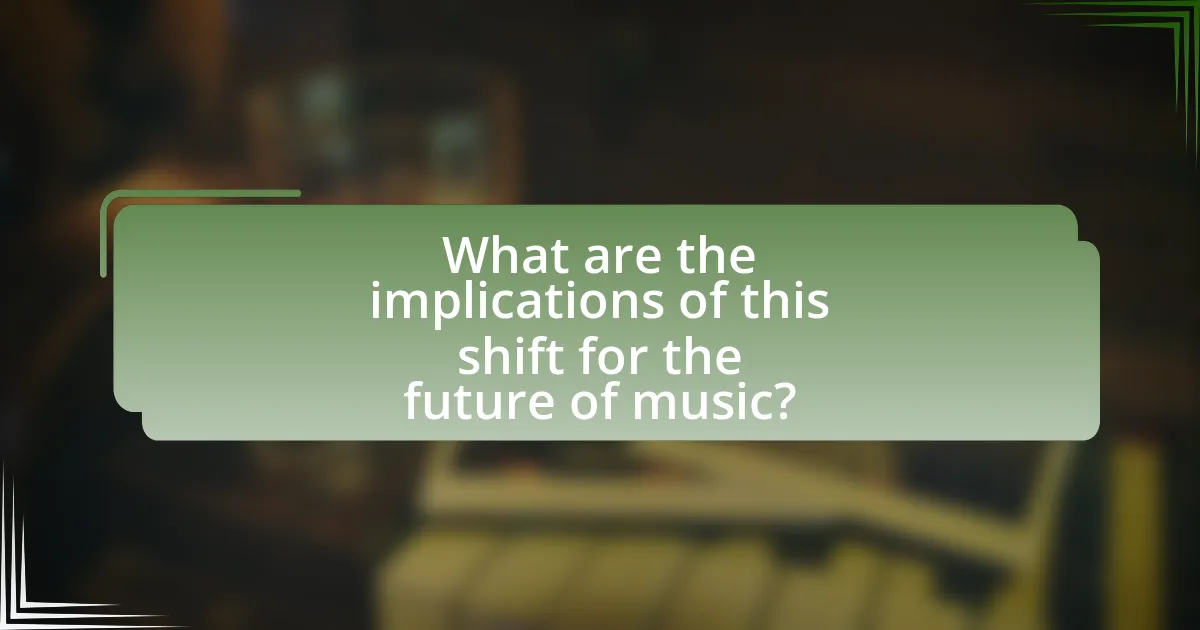
What are the implications of this shift for the future of music?
The shift from album-oriented rock to singles in the streaming era implies a fundamental change in how music is consumed and monetized. This transition leads to artists focusing on producing more singles rather than full albums, as streaming platforms prioritize individual tracks for playlists and algorithmic recommendations. Consequently, artists may experience increased pressure to release music more frequently to maintain visibility and engagement with listeners. Data from the Recording Industry Association of America indicates that streaming now accounts for over 80% of music industry revenue, highlighting the financial incentive for artists to adapt to this model. This shift also influences the creative process, as artists may prioritize catchy hooks and immediate appeal over cohesive album narratives, potentially altering the artistic landscape of music.
How might the music industry evolve in response to streaming trends?
The music industry may evolve by prioritizing single releases over full albums due to the dominance of streaming platforms. As streaming services like Spotify and Apple Music emphasize playlists and individual tracks, artists and labels are increasingly focusing on producing singles that can capture immediate listener attention. This shift is supported by data indicating that over 60% of music consumption now comes from singles rather than albums, reflecting changing consumer behavior. Consequently, artists may adopt more frequent release schedules, experiment with shorter formats, and leverage social media for promotional strategies, aligning with the instant gratification culture fostered by streaming.
What potential changes could occur in album production and marketing strategies?
Potential changes in album production and marketing strategies include a shift towards shorter, more frequent releases and a greater emphasis on digital marketing channels. As streaming platforms dominate music consumption, artists may prioritize singles over full albums to maintain listener engagement and capitalize on algorithm-driven playlists. This trend is supported by data showing that singles account for a significant portion of streaming activity, with the RIAA reporting that in 2020, single track revenues surpassed those of album revenues for the first time. Additionally, marketing strategies may increasingly leverage social media and influencer partnerships to promote individual tracks, reflecting the need for targeted outreach in a fragmented digital landscape.
How will artist-fan relationships be affected by the focus on singles?
The focus on singles will lead to more frequent and direct interactions between artists and fans, enhancing engagement. As artists release singles more regularly, fans will have more opportunities to connect with new music and updates, fostering a sense of immediacy and relevance. This shift encourages artists to maintain a consistent presence on social media and streaming platforms, which can strengthen the emotional bond with fans. Research indicates that artists who actively engage with their audience through regular single releases and social media interactions see increased fan loyalty and support, as evidenced by the rise of platforms like TikTok, where artists can promote singles and interact with fans in real-time.
What strategies can artists adopt to thrive in the streaming era?
Artists can thrive in the streaming era by focusing on releasing singles rather than full albums, as this aligns with listener behavior and platform algorithms. The shift towards singles allows artists to maintain a consistent presence in playlists and increase engagement, as streaming services prioritize frequent releases. Additionally, artists should leverage social media for direct fan interaction and promotion, enhancing their visibility and connection with audiences. Data shows that artists who release singles regularly can achieve higher streaming numbers and better chart performance, as evidenced by the rise of artists like Drake and Billie Eilish, who frequently release standalone tracks that capture listener interest.
How can artists effectively market their singles in a crowded space?
Artists can effectively market their singles in a crowded space by leveraging social media platforms, engaging with their audience, and utilizing targeted advertising. Social media allows artists to create buzz around their singles through teasers, behind-the-scenes content, and direct interaction with fans, which can lead to increased visibility and engagement. For instance, platforms like TikTok have become essential for music promotion, with viral trends significantly boosting song popularity; a study by the University of Southern California found that songs featured in TikTok videos saw a 300% increase in streams. Additionally, targeted advertising on platforms like Facebook and Instagram enables artists to reach specific demographics, ensuring their singles are promoted to the most relevant audiences. This combination of social media engagement and targeted marketing strategies is crucial for standing out in the competitive landscape of the streaming era.
What best practices should artists follow to engage their audience?
Artists should prioritize consistent and authentic communication with their audience to effectively engage them. This involves regularly sharing updates, behind-the-scenes content, and personal stories through social media platforms, which have been shown to increase fan interaction and loyalty. For instance, a study by the Pew Research Center indicates that 69% of adults in the U.S. use social media, making it a vital tool for artists to connect with their audience. Additionally, artists should leverage data analytics to understand audience preferences and tailor their content accordingly, as this approach has been proven to enhance engagement rates significantly.
